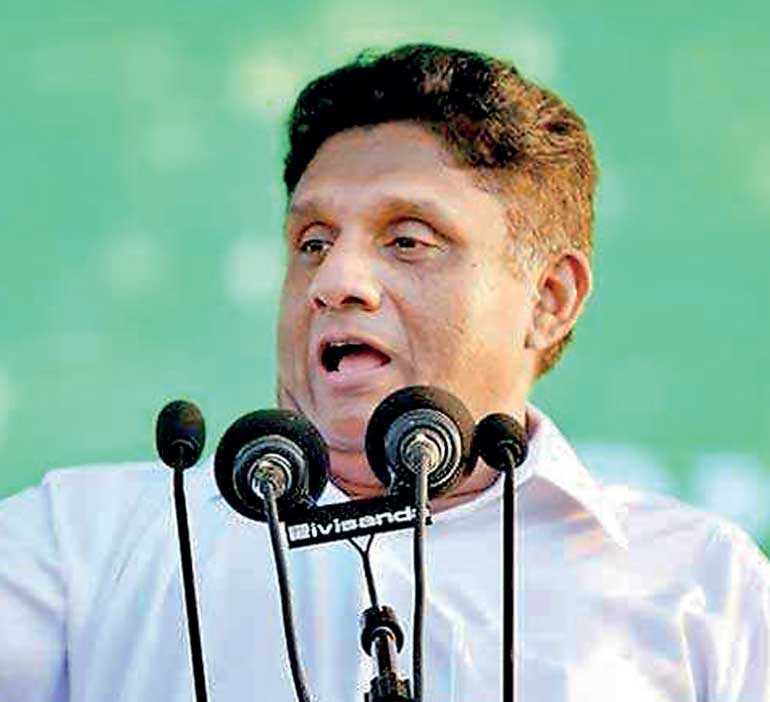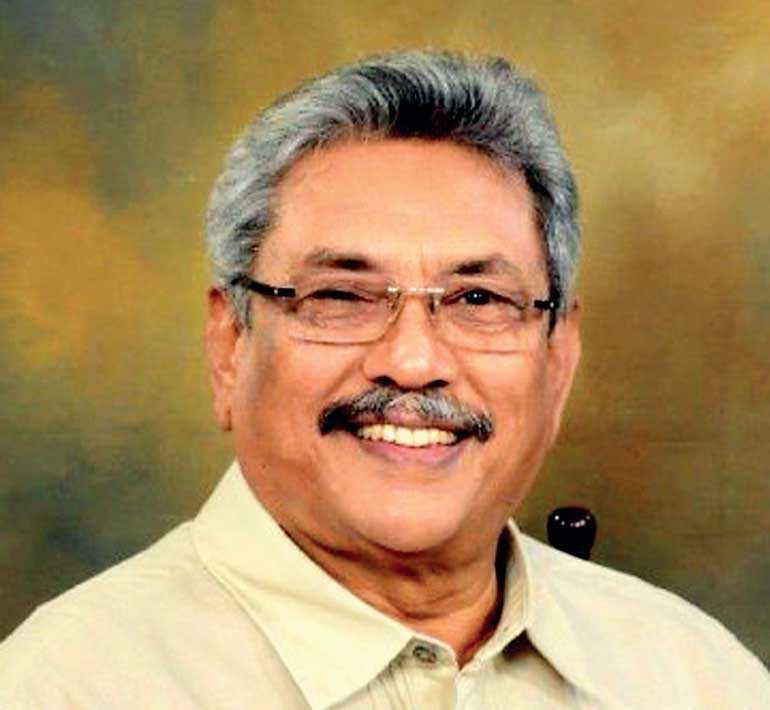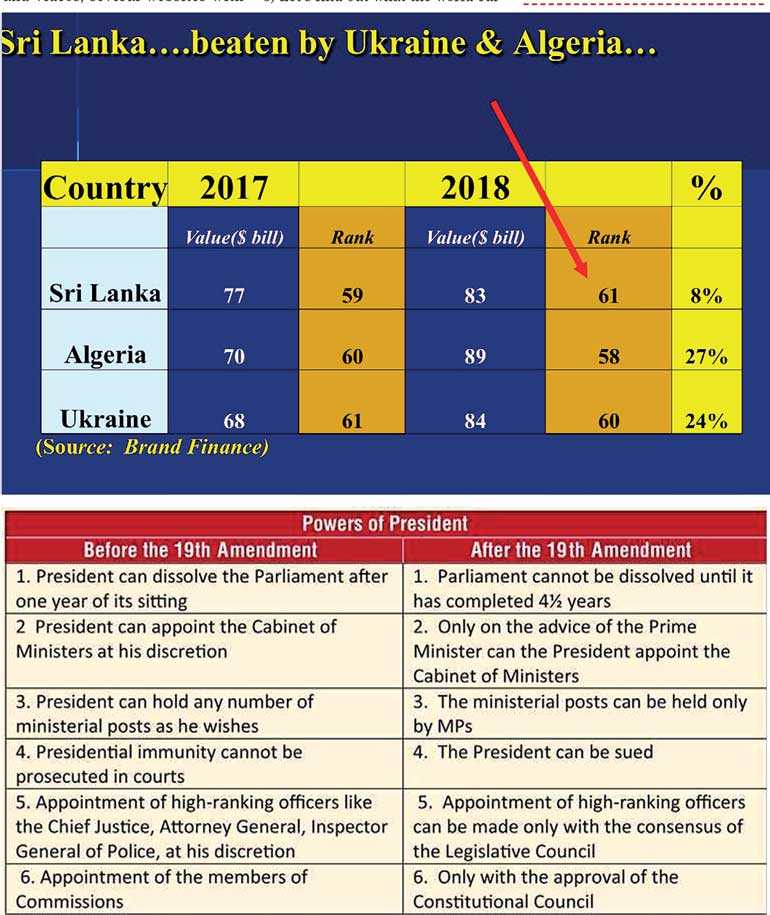Tuesday Apr 15, 2025
Tuesday Apr 15, 2025
Tuesday, 5 November 2019 00:00 - - {{hitsCtrl.values.hits}}



Sri Lanka is entering one of the most decisive time periods in recent history; just 11 days for the appointment of the new president of Sri Lanka. The manifestos of both key contenders are highly focussed on what Sri Lanka requires and must be commended. However, the question that many have  is about how many of these promises will be implemented. The Sri Lankan voter is wiser now and I guess the decision that comes out on 16 November will be a prudent one.
is about how many of these promises will be implemented. The Sri Lankan voter is wiser now and I guess the decision that comes out on 16 November will be a prudent one.
Both missed – Brand value crashing
Whilst both candidates have mentioned key requirements that a typical Sri Lankan voter wants in the manifesto, like corruption in the public sector not being allowed, that family members cannot be appointed to government ministries and any person with fraud allegations cannot hold public office were well accepted.
However, a key driver of economic growth has been not mentioned by both key presidential candidates, which is the key objective: Increasing nation brand value which is trailing at just $ 83 billion and beaten by countries like Algeria and Ukraine with a staggering 20% plus growth in the last two years.
A point that needs to be emphasised on nation brand value building is that: if a country doesn’t like its image – and most countries don’t – then the only way to change that image is through the things the country does, not by the things it says. On this front, may be if the selected new president does his task properly, then the nation brand value will naturally increase is what we see in real life.
Let me take a real-life demonstration of a country that has earned a reputation in a positive way, which I guess the two presidential candidates must take note of.
Best practice – Estonia
The Baltic countries (also known as Baltic States) is the north eastern region of Europe containing the countries of Latvia, Lithuania and Estonia on the Eastern Sea. These three countries, which became constituent republics of the former Soviet Union in 1940, regained their independence in 1991.
Estonia – a democratic parliamentary republic divided into 15 counties – has over 1,500 islands. The Estonian capital and largest city is Tallinn with a population of 1.29 million. Geographically, Estonia is on the north-eastern edge of the European Union, bordering Russia and Latvia.
Why did Estonia do the global push?
Post the war, Estonia knew that unless it latched on to the success of Europe it would once again go back to conflict. The senior advisors to the country hierarchy advocated a global push on the below logic. I guess Sri Lanka can pick up a lesson from this experience and the presidential candidates must take note. The objectives of the campaign were:
1) Differentiating and promoting one nation against other nations globally is the basic idea of earning a strong nation brand.
2) A strong nation brand can create a synergy of national assets and bolster a country’s global impact, helping to promote trade, investment and tourism.
3) In today’s competitive global market, nations are realising that their reputations, the image of them that the rest of the world sees, are vital to their growth and development. The label, or ‘brand’ that the rest of the world puts on them, can be either a valuable asset or a harmful detriment to their economy, industry, and relations with other countries.
Estonia – ‘Positively Transforming’
In the period 2001-2008 a campaign was launched by Estonia called ‘Positively Transforming’ to tell the world that Estonia as a country was undergoing transition in all spheres of its life and thus entering the world and European community, from which it had been isolated for years which is similar to what Sri Lanka must do.
The key objectives of this campaign were to increase the number of quality tourists and foreign investments and create a favourable acceptance for the Estonian export products in the world.
The first step was to gather opinions and ideas through interviews with residents and foreigners on what Estonia’s greatest strengths and best qualities were. From this information, they decided what perspective of themselves they would try to communicate to the rest of the world. The core qualities it came up with were Estonia’s rapid change and growth, rich history, vast, pristine natural landscape and the hopeful, positive attitude of its residents.
In order to manage the branding Estonia project in a more holistic and strategic manner, Estonian authorities created a new organisation called Enterprise Estonia. The creation of Enterprise Estonia helped to coordinate and oversee all nation branding-related activities by a single point. Estonia utilised art and aesthetics in the crafting of the visual symbol of its new brand.
‘Welcome to Estonia’ was the phrase chosen for Estonia’s campaign logo. With a strategic design and typeface, this logo has become widespread throughout the country, accepted by Estonia’s national airline, businesses, tourism industry, and shipping docks. The branding imagery and narratives were transmitted through and array of media; photographic style, colour palette and graphics and promoted through various communication channels, including short video documentaries, outdoor display campaigns and press events.
But a key point to remember was that all behaviour communicated to the world via political activities was on the theme ‘Positively Transforming’. A point emphasised by nation brand building experts like Simon Alholt who commented recently that if a country doesn’t like its image – and most countries don’t – then the only way to change that image is through the things the country does, not by the things it says. Estonia lived the promise.
Estonia – ‘Positively Surprising’
In 2008 Enterprise Estonia redeveloped its Estonian marketing campaign by breathing new life into the seven-year-old ‘Positively Transforming’ concept. The main objective of the new marketing concept, ‘Positively Surprising,’ was to position Estonia as an excellent place for visiting (tourism), excellent place for business (investments, export) and an excellent place for studying/working/living.
The primary target audience of the campaign consisted of four main categories:
Living environment – This consists of people who may come to Estonia for an extended period of time. They are also like tourists, but stay longer learn and partake in life, culture and environment of the country more than tourists. These people are the best source of promoters and opinion leaders to promote Estonia when they return home.
Tourism – People who come to Estonia to experience something new, and if positively surprised or delighted, will spread that to many others.
Business – These are the people, mainly mediators, entrepreneurs, investors or importers who directly and indirectly help create jobs, increasing the country’s wealth.
Internal citizens – They are part of heritage, history, culture, progress and achievement of the country; the best people to communicate about the values, heritage and history of the country to other nations in the world. To reach the above four categories, The Brand Estonia campaign used two main approaches – external communication and internal communication. The External Communication Strategy – Brand Mark: ‘Welcome to Estonia’.
The external communication strategy was divided into three sub-strategies based on the main interest for coming to Estonia:
Business: ‘It is easy to do complex business transactions.’
Tourism: ‘An old country in a Shiny Package,’ under this Estonia promotes four types of holiday packages such as city holiday/cultural holiday/wellness holiday/nature holiday.
Living Environment: ‘An Exciting Outlook on Ordinary Life’; under that the different options available are for Living, Learning and Working.
Internal Communication Strategy: ‘I Love Estonia’ is the other side of the ‘Welcome to Estonia’ medal. While ‘Welcome to Estonia’ is an invitation directed to foreign countries, ‘I Love Estonia’ encourages its own citizens in creating this new brand. The rationale behind the campaign is to reinforce the Estonians’ pride in their country, foster domestic tourism and overall to strengthen the link among the people, as well as between the people and the country.
Manifestations/demonstrations of Estonia’s nation branding are very diverse and numerous. They include dozens of brochures, presentations and videos, several websites with immense amounts of information and more.
The results
Brand Estonia increased in value by 24.6% in the ‘Brand Finance – Nation Brands 100,’ outperforming every other nation brand in the European Union. Estonia was the third fastest growing nation brand of the 100 surveyed which is what Sri Lanka needs to do. We have to become a top 25 nation within the next five years.
Next steps for Sri Lanka
1) The new president must clearly chalk-out what we want the world to perceive us to be.
2) Identify the key target markets globally and internally just like what Estonia did.
3) Let’s find out what the world currently thinks of Sri Lanka as a brand. Estonia did wide stakeholder consultations pre-2001 strategy
4) Based on the desired image we want Sri Lanka to be, a clear policy statement must be developed with all missions overseas understanding the logic by the new president of Sri Lanka.
5) All stakeholders to this policy – general public, Government and Opposition, which is the challenge.
6) We need to walk the talk in making the desired image come to life. Especially in a political economy this requires rigour. The task is easier given that new presidential hopeful manifesto is strong.
7) Monitor the global perceptions scientifically and not by just statements of the diaspora that can be coloured sometimes.
8) Track the global media, especially viral and below-the-line media.
A point to note is that at the end of the day, the brand custodians when it comes to a nation brand are the people. It is only the people of the country who can take it forward and for this we must be transparent and honest in decision making when it comes to social issues. As at now, to be honest, it is sad how we keep hurting brand Sri Lanka when there is so much going good for the country.
(Dr. Athukorala is a multiple award-winning marketer and is the CEO/President of the AI company Clootrack for Sri Lanka, Maldives and Pakistan Based in Sri Lanka. He is an alumnus of Harvard University).
Discover Kapruka, the leading online shopping platform in Sri Lanka, where you can conveniently send Gifts and Flowers to your loved ones for any event including Valentine ’s Day. Explore a wide range of popular Shopping Categories on Kapruka, including Toys, Groceries, Electronics, Birthday Cakes, Fruits, Chocolates, Flower Bouquets, Clothing, Watches, Lingerie, Gift Sets and Jewellery. Also if you’re interested in selling with Kapruka, Partner Central by Kapruka is the best solution to start with. Moreover, through Kapruka Global Shop, you can also enjoy the convenience of purchasing products from renowned platforms like Amazon and eBay and have them delivered to Sri Lanka.
Discover Kapruka, the leading online shopping platform in Sri Lanka, where you can conveniently send Gifts and Flowers to your loved ones for any event including Valentine ’s Day. Explore a wide range of popular Shopping Categories on Kapruka, including Toys, Groceries, Electronics, Birthday Cakes, Fruits, Chocolates, Flower Bouquets, Clothing, Watches, Lingerie, Gift Sets and Jewellery. Also if you’re interested in selling with Kapruka, Partner Central by Kapruka is the best solution to start with. Moreover, through Kapruka Global Shop, you can also enjoy the convenience of purchasing products from renowned platforms like Amazon and eBay and have them delivered to Sri Lanka.